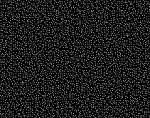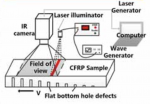Dear guys, I am working on a research project for defect detection. The idea is to project laser speckle on a plastic plate, and analyze the temperature map on the plate to localize the defect. Right now I have two questions to set up the system. Any suggestion is appreciated.
1. Do you have laser projector recommended, which could generate uniform dot patterns like follows?

2. For defect analysis, each laser dot need to heat up that local area 1 celsius (best within 0.5 sec). The plate is made of plastic, 1 meter by 1 meter. How much power do you think is required for the laser source?
Thank you very much!
Thomas (from California)
1. Do you have laser projector recommended, which could generate uniform dot patterns like follows?

2. For defect analysis, each laser dot need to heat up that local area 1 celsius (best within 0.5 sec). The plate is made of plastic, 1 meter by 1 meter. How much power do you think is required for the laser source?
Thank you very much!
Thomas (from California)




